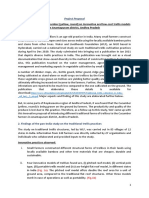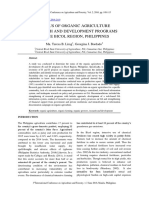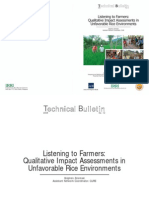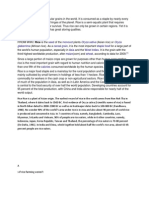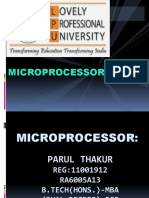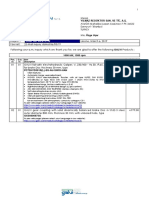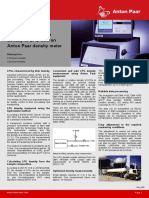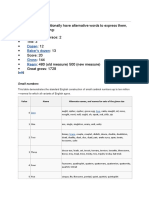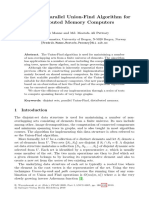Chapter 1 (Intro Rice)
Chapter 1 (Intro Rice)
Uploaded by
Ash Njelic HamolCopyright:
Available Formats
Chapter 1 (Intro Rice)
Chapter 1 (Intro Rice)
Uploaded by
Ash Njelic HamolOriginal Title
Copyright
Available Formats
Share this document
Did you find this document useful?
Is this content inappropriate?
Copyright:
Available Formats
Chapter 1 (Intro Rice)
Chapter 1 (Intro Rice)
Uploaded by
Ash Njelic HamolCopyright:
Available Formats
Chapter One
THE PROBLEM AND ITS SETTING Introduction Rice (Oryza Sativa) is one of the most popular grains in the world. As a cereal grain, it is the most important staple food for a large part of the world's human population. Rice is a semi-aquatic plant that requires constant moist conditions for survival, thus rice can only be grown in certain regions like Philippines and other Asian countries. Yet it is relatively easy to grow and has great storing qualities. It is the grain with the third-highest worldwide production, after maize(corn) and wheat, according to data for 2009. (http As a durable crop that can be relied on to bring good harvest year in and year out, rice is grown in some 3.2 million hectares of land, providing livelihood to more than two million households engaged in rice-based farming, along with millions of farm laborers, and tens of thousands of merchants and traders. (http Rice also plays important macroeconomic and developmental roles but despite of its importance,the rice farmers remain poorer than other crop farmers for some reasons. Although the rice research community has been consistent on introducing different technology and techniques to provide this food for expanding population, challenges are still looming ahead, more rice must be produced on less land,less water, less labor and less cost. Globally, food supply is threatened by a growing demand to feed an increasing population in the face of scarcity in land and water resources. Thus, climate change is also a big challenge on providing this staple food especially in this tropical region.
The problem facing in Bicol Region, particularly in Albay, rice production is abundant but in recent years, due to the expanding population along with the climate change and hazards (floods,typhoons, La Nia and El Nia phenomenon), affects the rice production. Hence, due to climate change, a need to fabricate a small biomass reversible paddy dryer is highly essential in order to help the farmers to dry the paddy without the use of sun- drying method and different traditional drying methods. Aside from the rice postharvest operations (cutting,pilling,threshing,hauling,drying storing and processing), drying is the most important because drying is the process that reduces grain moisture content to a safe level for storage and it is the most critical operation after harvesting the rice crop. Although, the sun-drying and other traditional methods utilizes natural energy source and does not need to purchase machine and utilizes unskilled labor, it cannot be done during rainy season. With the lack of mechanical dryers, lossess will increase since the grains can deteriorate and germinate. In this present day civilization, there are dyer models that had been introduced and researched by concerned government sectors yet, the efficiency of the different dryer models are of different levels. There are dryer model that are too expensive and difficult to operate and it is difficult to promote to the guild of farmers and traders. Furthermore, the researcher aims to fabricate a small biomass paddy dryer.
Objectives of the Study
The general objectives of the study was to design,fabricate and to conduct a preliminary test to evaluate the performance of a small biomass reversible paddy dryer. Specifically, this study aimed to: 1. To determine the physical properties of rice and corn to be used in dring in terms of : 1.1 Bulk density, kg/m3 1.2 Moisture content, % 2. To evaluate the furnace performance in terms of: 2.1 Feeding rate, kg/hr
2.2 Spontaneous combustion time 2.3 Fuel consumption rate,kg/hr 2.4 Burning efficiency,% 2.5 Heat available, kcal/hr 3. Dtermine the dryer performance in terms of: 3.1 Drying capacity, kg/hr 3.2 Drying rate, kg/hr 3.3 Drying recovery, %, 4. Determine the physical Characteristics of the fresh and dried rice and corn samples such as: 4.1 Weight, kg 4.2 Moisture content, % 4.3 Bulk Density, kg/m3 5. Evaluate the quality of the dried product in terms of: 5.1 color 6. To assess and compare the drying parameters of the small reversible biomass paddy dryer, namely: 6.1 Drying rate, kg/hr 6.2 Moisture reduction rate, % 6.3 Moisture content gradient, % 6.4 Heat utilization, kcal/hr 6.5 Heating system efficiency, % 6.6 Drying efficiency, %
6.7 Drying system efficiency, % 7. Determine the fabrication cost of the machine 8. Determine the operational cost of using the small biomass reversible paddy dryer and test samples.
Significance of the Study
An average Filipino diet is based on rice. It provides half of our calorie requirements and onethird of our protein intake. Rice accounts for 20% of food expenditures for average households, which increases to 30% for households belonging to the bottom third of our society. Rice, as a food staple, is an economic commodity. It is both a major expenditure item and a source of income for many households. It is mainly cultivated by small farmers in holdings of less than 1 hectare. Rice is also a wage commodity for workers in the cash crop or non-agricultural sectors. Hence, the production of rice is affected by the erratic weather condition. Considering the importance of rice and the instantaneous changing of climate, the researchers fabricated a small biomass reversible paddy dryer in order to promote the drying technique introduced by Vietnam and Philippine Rice Research Institute (PhilRice) to the farmers as well as to justify the machine efficiency and the drying level of paddy than of the traditional drying method. This fabricated machine will also contribute to the laboratory learning of the BS in Agricultural Engineering Students in BUCAF as their medium in Engineering Process Laboratory and the like. This study will likewise serve as a reference for other researchers. Henceforward, development for the rice postharvest industry will contribute to the farmers, merchants, and traders as well as to the agricultural economy of our country which belongs Bicol Region.
Scope and Delimitation of the Study
This study was conducted at the Agricultural Engineering Department of Bicol University College of Agriculture and Forestry (BUCAF), Guinobatan, Albay from the month of April 2012 to October 2012. The study was limited to the fabrication, testing and performance evaluation of the Small Biomass Reversible Paddy Dryer (tons capacity). The machine will be fabricated in Bicol University College of Agriculture and forestry (BUCAF) Agro-Industrial Shop Machine Shop. The machine will be tested in terms of drying capacity, drying rate, drying recovery, moisture reduction rate, moisture content gradient, heat utilization, heating system efficiency, drying efficiency, drying system efficiency. On the other hand, further studies with regards to other rice postharvest stages, production, and other researchable area are not covered by this study. Fresh harvested paddy will be used throughout the study. Hence, the main focus of this study is to present the results of the performance evaluation and the accuracy of the fabricated small biomass reversible paddy dryer. The fabrication, actual testing, and evaluation of the machine will be guided by the working drawing and method of performance evaluation.
You might also like
- 1-RICE Full ProposalDocument118 pages1-RICE Full Proposalanna reham lucmanNo ratings yet
- Research 09 04 19Document19 pagesResearch 09 04 19Aianna Abragan100% (1)
- Final Practicum Report (Sourav)Document64 pagesFinal Practicum Report (Sourav)Mohammad WalidNo ratings yet
- RiceDocument66 pagesRiceAnkush Ahirrao100% (2)
- Thesis 04Document22 pagesThesis 04Marlexis ConacoNo ratings yet
- Omar M Moma Thesis Outline 2Document20 pagesOmar M Moma Thesis Outline 2Nor-Ton NB BatingkayNo ratings yet
- Thesis Proposal, MaroDocument18 pagesThesis Proposal, MaroLyka Andayog100% (1)
- Agronomic EfficiencyDocument23 pagesAgronomic Efficiencynaser daculaNo ratings yet
- Agricultural Productivity of Selected Philippine Crops Effect of Climate Change in Cotabato ProvinceDocument5 pagesAgricultural Productivity of Selected Philippine Crops Effect of Climate Change in Cotabato ProvinceInternational Journal of Innovative Science and Research TechnologyNo ratings yet
- How Sustainable Is Organic Agriculture in The Phils Rodel G. Maghirang Et AlDocument33 pagesHow Sustainable Is Organic Agriculture in The Phils Rodel G. Maghirang Et AlianmaranonNo ratings yet
- Project Proposal (Revised) - Pilot Project On Cucumber Cultivation On Trellises - 30 July 2021Document8 pagesProject Proposal (Revised) - Pilot Project On Cucumber Cultivation On Trellises - 30 July 2021PEDDI REDDYNo ratings yet
- Guyabano ProductionDocument8 pagesGuyabano ProductionCharlie UyNo ratings yet
- Biological Control To Maintain Natural Densities of Insects and Mites by Field Releases of Lady Beetles (Coleoptera - Coccinellidae)Document7 pagesBiological Control To Maintain Natural Densities of Insects and Mites by Field Releases of Lady Beetles (Coleoptera - Coccinellidae)Juan Vera SanchezNo ratings yet
- Unit 2 LESSON 1-3 SOIL CONSERVATION AND MANAGEMENTDocument42 pagesUnit 2 LESSON 1-3 SOIL CONSERVATION AND MANAGEMENTvimbee alipoonNo ratings yet
- Status of Organic Agriculture Research and Development Programs in The Bicol Region, PhilippinesDocument8 pagesStatus of Organic Agriculture Research and Development Programs in The Bicol Region, PhilippinesMario Montes100% (1)
- Sip JJJJDocument34 pagesSip JJJJRosalyn Marie Morales SugayNo ratings yet
- Support SubsystemDocument10 pagesSupport SubsystemBelliang BNo ratings yet
- P119 Berisso An Analysis of The Impact of Climate Variation EthiopiaDocument31 pagesP119 Berisso An Analysis of The Impact of Climate Variation EthiopiaPär SjölanderNo ratings yet
- Corn Roadmap 2011-2017Document32 pagesCorn Roadmap 2011-2017philmaize100% (5)
- Price Intervention and Protectionist PoliciesDocument25 pagesPrice Intervention and Protectionist PoliciesDenise Agbong Gonzaga100% (1)
- Effect of Moringa Supplementation On Growth and Health - Golden Leash Pet ProductsDocument58 pagesEffect of Moringa Supplementation On Growth and Health - Golden Leash Pet ProductsGolden Leash Pet ProductsNo ratings yet
- Pechay PDFDocument12 pagesPechay PDFCarlos Peconcillo IMPERIALNo ratings yet
- What Is AdlaiDocument5 pagesWhat Is AdlaiJessielito P. AmadorNo ratings yet
- RRLDocument6 pagesRRLPatricia Mae D. RamboangaNo ratings yet
- Chapter 1. Intro To AgricultureDocument42 pagesChapter 1. Intro To AgricultureAmiema M. NoorNo ratings yet
- Awareness of Carabao Raisers On The Incidence of Parasitic Liver FlukeDocument29 pagesAwareness of Carabao Raisers On The Incidence of Parasitic Liver FlukeArvin Manalo100% (1)
- Thesis Outline of Martin H. ButacDocument7 pagesThesis Outline of Martin H. ButacRovieda ButacNo ratings yet
- Ding Julianne 10DDocument21 pagesDing Julianne 10DjulianneNo ratings yet
- Calendar-Based Pest ManagementDocument14 pagesCalendar-Based Pest ManagementRafael100% (1)
- Module (Fluid Mechanics)Document3 pagesModule (Fluid Mechanics)Kenneth Roy MatuguinaNo ratings yet
- Yama ASDocument10 pagesYama ASJosh SchultzNo ratings yet
- Review of Related Leterature-FDocument18 pagesReview of Related Leterature-FArnel SisonNo ratings yet
- Listening To Farmers: Qualitative Impact Assessments in Unfavorable Rice EnvironmentsDocument53 pagesListening To Farmers: Qualitative Impact Assessments in Unfavorable Rice EnvironmentsIRRI_resources100% (1)
- Cost and Return Analysis of Small-Scale Production of of CultivationDocument8 pagesCost and Return Analysis of Small-Scale Production of of CultivationdetailsNo ratings yet
- Review of Related Literature and StudiesDocument3 pagesReview of Related Literature and Studiesjek vinNo ratings yet
- Chapter 1Document3 pagesChapter 1Ren Arrivas Bolaños100% (1)
- Banana PDFDocument47 pagesBanana PDFjrderamaNo ratings yet
- PowerPoint Presentation in IPMDocument59 pagesPowerPoint Presentation in IPMDarwin M. CacalNo ratings yet
- Ledesma Ip 2Document56 pagesLedesma Ip 2Toto Nick LedesmaNo ratings yet
- My NarrativeDocument28 pagesMy NarrativeGauis Laurence CaraoaNo ratings yet
- Cultural Practices Urban AreasDocument5 pagesCultural Practices Urban AreasryeueNo ratings yet
- Farmers' Handbook On Introduced and Local Banana Cultivars in The PhilippinesDocument78 pagesFarmers' Handbook On Introduced and Local Banana Cultivars in The PhilippinesAnonymous dtceNuyIFINo ratings yet
- Finalll Na I2Document25 pagesFinalll Na I2Rafael pastranaNo ratings yet
- The Causes of Post-Harvest Losses in Maize and Their Effects On The Profitability of Agribusiness Enterprises in Masindi MunicipalityDocument82 pagesThe Causes of Post-Harvest Losses in Maize and Their Effects On The Profitability of Agribusiness Enterprises in Masindi MunicipalityATEGEKA STEWART100% (2)
- ThesisDocument161 pagesThesisRanjan SarmahNo ratings yet
- Effect of Fertigation On Growth, Yield and Quality of Okra (Abelmoschusesculentus L. Moench)Document6 pagesEffect of Fertigation On Growth, Yield and Quality of Okra (Abelmoschusesculentus L. Moench)Editor IJTSRDNo ratings yet
- Effect of Application Rate of Urea On The Growth, Bulb Yield and Quality of OnionDocument10 pagesEffect of Application Rate of Urea On The Growth, Bulb Yield and Quality of OnionRadwan AjoNo ratings yet
- Outline of Stringbeans/Polebeans: Phaseolus VulgarisDocument4 pagesOutline of Stringbeans/Polebeans: Phaseolus VulgarisHanie HindawiNo ratings yet
- Life Cycle of Rice PlantDocument49 pagesLife Cycle of Rice Plants_begum86% (7)
- 3i-Winsome (4) Print BukasDocument12 pages3i-Winsome (4) Print Bukasbea pegadNo ratings yet
- Outline, Danila, 11Document20 pagesOutline, Danila, 11LEAH MAE CANDADO100% (1)
- The Butaw's Mini Piggery and Hog ServicesDocument14 pagesThe Butaw's Mini Piggery and Hog ServicesJM MyrtesNo ratings yet
- Thesisssss Malapit Na Matapos ShetDocument30 pagesThesisssss Malapit Na Matapos ShetMhvn SMNo ratings yet
- Ampalaya: Farmer Factsheet - IpmDocument6 pagesAmpalaya: Farmer Factsheet - IpmMarjunex PedrosoNo ratings yet
- Squash (Cucurbita Pepo L.) Growth and Yield in Response To Different Types of Fertilizers (Farmyard, Chicken Manures, Urea and NPK Granules)Document126 pagesSquash (Cucurbita Pepo L.) Growth and Yield in Response To Different Types of Fertilizers (Farmyard, Chicken Manures, Urea and NPK Granules)Anonymous V53hX2nrTNo ratings yet
- Pests of Field Crops and Pastures: Identification and ControlFrom EverandPests of Field Crops and Pastures: Identification and ControlPT BaileyNo ratings yet
- From Wiki:: Oryza Sativa Oryza GlaberrimaDocument26 pagesFrom Wiki:: Oryza Sativa Oryza GlaberrimaAsh Njelic HamolNo ratings yet
- Smart Integration in Agriculture An Arduino-DrivenDocument20 pagesSmart Integration in Agriculture An Arduino-DrivenLloyd MedenillaNo ratings yet
- Design and Study of Grain DryerDocument101 pagesDesign and Study of Grain DryerAD DNo ratings yet
- L28-32H GenSet TierII PDFDocument318 pagesL28-32H GenSet TierII PDFPhilippe DAVID100% (1)
- Sen. Pete Domenici Special SectionDocument12 pagesSen. Pete Domenici Special SectionAlbuquerque Journal100% (1)
- MATH 8-Budget-of-WorkDocument67 pagesMATH 8-Budget-of-WorkMaricel ManlupigNo ratings yet
- 2010 Baars PRDocument17 pages2010 Baars PRمحمد حسنNo ratings yet
- Differential Protection - Proven Technique For More Than 50 Years - EEPDocument6 pagesDifferential Protection - Proven Technique For More Than 50 Years - EEPAbdul Mohid SheikhNo ratings yet
- CfeiDocument1 pageCfeiglademierNo ratings yet
- Maldives Diving BrochureDocument4 pagesMaldives Diving BrochureMaldives Dive TravelNo ratings yet
- Questions & Answers On Resistors: 1. Define ResistanceDocument7 pagesQuestions & Answers On Resistors: 1. Define ResistanceTanmay HazraNo ratings yet
- Specification Tender No 2122020001 AT1OBiiDocument441 pagesSpecification Tender No 2122020001 AT1OBiiMahendra KumarNo ratings yet
- Is Management A Science or ArtDocument2 pagesIs Management A Science or ArtCyryhl GutlayNo ratings yet
- Graptolites in British StratigraphyDocument66 pagesGraptolites in British StratigraphyAbel Ramirez AmpueroNo ratings yet
- Baphomet 1Document2 pagesBaphomet 1AtazothnashaasNo ratings yet
- ProcessorDocument22 pagesProcessorVishal ChetalNo ratings yet
- GPS Over Fiber System: CommunicationDocument6 pagesGPS Over Fiber System: CommunicationРоман ДенчикNo ratings yet
- Jakeman Etal 2006 Model Development and EvaluationDocument13 pagesJakeman Etal 2006 Model Development and EvaluationFaizal RohmatNo ratings yet
- GE Practical 10Document2 pagesGE Practical 10ronisharora11No ratings yet
- Galvi Newcomen 49.271-10 PDFDocument10 pagesGalvi Newcomen 49.271-10 PDFCanan DönmezNo ratings yet
- Software Engineering BasicsDocument12 pagesSoftware Engineering BasicsNITISH DASA100% (1)
- Determination of The Density of LPG With An Anton Paar Density MeterDocument1 pageDetermination of The Density of LPG With An Anton Paar Density MeterRadient MushfikNo ratings yet
- BHMN Svi II AP QSG 19679ac X 1221 EnglishDocument92 pagesBHMN Svi II AP QSG 19679ac X 1221 Englishhabib229No ratings yet
- Koch Postulate CoronadoDocument4 pagesKoch Postulate CoronadoCORONADO, Jessa Marie A.No ratings yet
- Dozen Baker's Dozen Gross Ream: Small NumbersDocument5 pagesDozen Baker's Dozen Gross Ream: Small Numberssanjumaur5787No ratings yet
- Computational and Mathematical Methods in Science and EngineeringDocument4 pagesComputational and Mathematical Methods in Science and EngineeringAndres Acevedo MejiaNo ratings yet
- Cövyxi Wewfbœzv I Köwyweb VM: Animal Diversity and ClassificationDocument14 pagesCövyxi Wewfbœzv I Köwyweb VM: Animal Diversity and ClassificationabbagamingofficialNo ratings yet
- Study of Reliability Analysis of CVT SystemDocument13 pagesStudy of Reliability Analysis of CVT Systemswapnil pandeNo ratings yet
- Rokka No Yuusha Volume 4 - Chapter 1 - 5 Part 3Document176 pagesRokka No Yuusha Volume 4 - Chapter 1 - 5 Part 3Bins SurNo ratings yet
- Radiation SafetyDocument69 pagesRadiation SafetyJay Lawson100% (1)
- Class-2 - Truss Analysis - MOJ - DR Nazrul - 1Document12 pagesClass-2 - Truss Analysis - MOJ - DR Nazrul - 1Ann Nazmun SakibNo ratings yet
- A Scalable Parallel Union-Find Algorithm For Distributed Memory ComputersDocument10 pagesA Scalable Parallel Union-Find Algorithm For Distributed Memory Computerslokesh guruNo ratings yet
- IGCSE Physics Worksheet 15.1Document1 pageIGCSE Physics Worksheet 15.1Alex Datsyuk0% (1)










